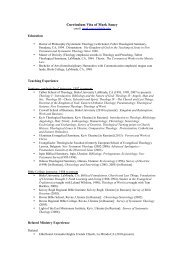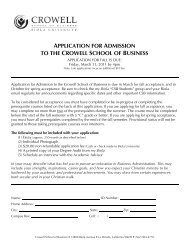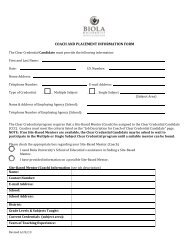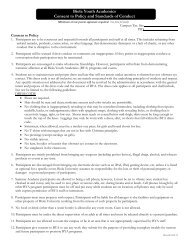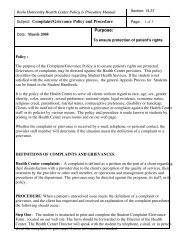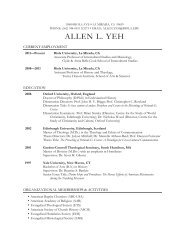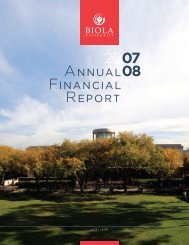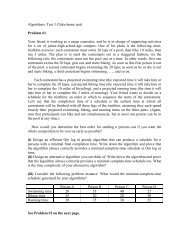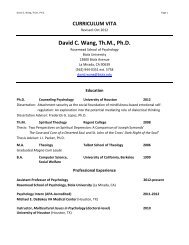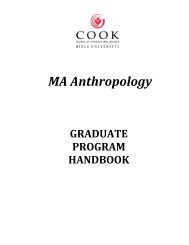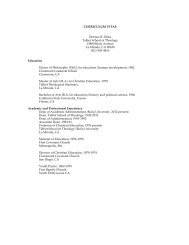The Biola University Academic Plan emanates from our mission and ...
The Biola University Academic Plan emanates from our mission and ...
The Biola University Academic Plan emanates from our mission and ...
- No tags were found...
Create successful ePaper yourself
Turn your PDF publications into a flip-book with our unique Google optimized e-Paper software.
<strong>our</strong> six schools the ratios vary widely <strong>from</strong> 57% male <strong>and</strong> 43% female in one school to 90% male<strong>and</strong> 10% female in another.Accomplishing this initiative will require an equally aggressive effort in the related facility m<strong>and</strong>ate<strong>and</strong> faculty housing initiative.Tactical Objectives• Over the next five years, reduce the full-time faculty to FTE student enrollment <strong>from</strong> 26.5 to20. Assuming a 5% FTE enrollment increase each year, this means that by the 2010-2011academic year we will have an FTE enrollment of 6,465 <strong>and</strong> will need to recruit 132 newfaculty or 26 new faculty each year for the next five years.• Create a new faculty budgeting model so that for each new faculty position adequate fundsare provided to support faculty development <strong>and</strong> associated operational costs (e.g., funds forconference travel, sabbatical, other faculty development, housing, faculty office furniture <strong>and</strong>equipment, <strong>and</strong> at critical junctures additional 02 <strong>and</strong> 03 support for academic programs).Action <strong>Plan</strong>• A conservative cost estimate for these positions is $10,926,000 (assuming salary at theAssistant 2B level with benefits <strong>and</strong> a salary/benefits increase of 3.5% each year <strong>and</strong> $9,000for housing <strong>and</strong> other support).• Because it will take some time to recruit faculty <strong>and</strong> create new faculty offices, <strong>and</strong> becauseonly 8 of the requested 16 new faculty positions were approved for 2006-07, add new facultyincrementally. Table 2 presents a possible faculty expansion plan for the next five years.Table 2.Faculty Expansion <strong>Plan</strong>Year New Faculty Estimated Cost2006-07 8 funded2007-08 15 $1,227,0002008-09 25 $2,116,0002009-10 40 $3,504,0002010-11 44 $4,079,000Total 132 $10,926,000Page 6 of 208/13/07<strong>Biola</strong> <strong>University</strong> <strong>Academic</strong> <strong>Plan</strong>
Facilities M<strong>and</strong>ateIn order to support <strong>our</strong> current number of students <strong>and</strong> faculty <strong>and</strong> to accommodate furthergrowth, there is an urgent need to acquire, renovate, <strong>and</strong> build new learning <strong>and</strong> living environments,designed to support academic excellence <strong>and</strong> inspire spiritual renewal. We are faced with a criticalneed for updated <strong>and</strong> new classrooms as well as faculty offices <strong>and</strong> other academic space. <strong>The</strong>addition of the new Crowell School of Business is a welcome addition, but will not meet currentneeds. Assuming the implementation of the faculty expansion m<strong>and</strong>ate <strong>and</strong> completion of the newCrowell School of Business, in the next five years we will need at least 30 new classrooms <strong>and</strong> 177new faculty offices – 132 offices to accommodate new faculty <strong>and</strong> another 45 offices toaccommodate current faculty in temporary quarters. Over the past two years of discussions withinUPG <strong>and</strong> with faculty across the campus, the highest priority is for new construction <strong>and</strong> renovationof academic buildings to house classrooms, faculty offices, <strong>and</strong> academic programs.Table 3 profiles the impact of growth with respect to selected variables on <strong>our</strong> campus, comparingthe situation in Fall 2001 with Fall 2005.Table 3.Growth Impact on Selected VariablesVariable Fall 2001 Fall 2005 % IncreaseTotal FTE enrollment 3,842 5,066 32%Credit H<strong>our</strong>s – Undergraduate 40,916 51,362 26%Credit H<strong>our</strong>s – Adult Programs 2,309 4,812 108%Credit H<strong>our</strong>s – Graduate 9,173 12,896 41%On-campus c<strong>our</strong>ses taught 1,117 1,569 40%On-campus classrooms 86 104* 21%* (13%)Square foot per student 245.7 245.6**Faculty offices 170 239*** 41%*** (9%)* <strong>The</strong> increase on classrooms includes 7 temporary classrooms <strong>and</strong> a number of specialpurpose seminar rooms in Rose Hall for Rosemead School of Psychology. <strong>The</strong>increase in permanent classrooms is 13%.** <strong>The</strong> square foot per student ratio is the result of the new library, Hope Hall, <strong>and</strong> thegym <strong>and</strong> café expansions. Only modest academic space was added with theremodel of Rose Hall.*** <strong>The</strong> actual increase in permanent faculty offices is 9%. 45 faculty are currently intemporary spaces in the Bardwell Annex, the Grove modulars, <strong>and</strong> Rose. Inaddition, some of these offices are occupied by support staff or shared by adjuncts.Tactical Objectives• Create new faculty offices (45) to provide for current office shortages in which faculty arehoused in temporary facilities like Bardwell annex <strong>and</strong> Grove, <strong>and</strong> to accommodate newfaculty growth (132) over the next 5 years.• Create new academic buildings <strong>and</strong> classrooms.• Renovate existing buildings that are no longer adequate – Bardwell, Sutherl<strong>and</strong>, Soubirou–<strong>and</strong> upgrade of faculty offices <strong>and</strong> classrooms (furniture replacement, etc.)• Exp<strong>and</strong> into existing off-campus facilities (e.g., SPS sites like South O.C. <strong>and</strong> Vista)Page 7 of 208/13/07<strong>Biola</strong> <strong>University</strong> <strong>Academic</strong> <strong>Plan</strong>
• Acquire off-campus facilities.• Pursue facilities projects concurrently.Action <strong>Plan</strong>To meet immediate Fall 06 <strong>and</strong> Fall 07 needs:• Create new faculty offices for Fall 06.• Relocate some existing academic programs to off-campus locations.• Move aggressively to relocate some non-instructional offices to off-campus.• Begin fund raising for <strong>and</strong> complete the renovation of studios on South Campus <strong>and</strong>additional improvements to South Campus.To meet needs beyond 2007:Table 4.Facilities Construction <strong>and</strong> RenovationBuilding Estimated Cost Targeted Completion DateCurrently Approved ProjectsCrowell School of Business Completed CompletedMyers Expansion $55,000,000 Fall 2008Projects Being ConsideredSutherl<strong>and</strong> Expansion $2,400,000 Spring 2008Bardwell $15,000,000 Fall 2010Parking Structure $8,200,000 Fall 2008Other Priority ProjectsSouth Campus $45,000,000 Spring 2010Gym Locker Expansion $2,000,000 Spring 2009Convocation Center $58,000,000 Fall 2011Sub Redevelopment $20,000,000 Fall 2013Total $180,600,000Page 8 of 208/13/07<strong>Biola</strong> <strong>University</strong> <strong>Academic</strong> <strong>Plan</strong>
Advance Educational ExcellenceF<strong>our</strong> Directions: <strong>The</strong> <strong>Academic</strong> InitiativesAs an exemplary Christian university we are committed to educational excellence—equipping men <strong>and</strong> women in mind <strong>and</strong> character to impact the world for the Lord Jesus Christ.Essential to the pursuit of educational excellence is providing opportunities <strong>and</strong> res<strong>our</strong>ces for faculty<strong>and</strong> students to identify their callings, carry out their scholarship <strong>and</strong> creativity, connect with theircolleagues, <strong>and</strong> realize the contributions they can make to the university, the academy, <strong>and</strong> theworld. <strong>The</strong>refore, we are launching the following academic initiatives to advance educationalexcellence:♦ Reform the Core of <strong>our</strong> Undergraduate CurriculumIn French, to receive an education is to receive a ‘formation.’ We think that idea captureswell <strong>our</strong> hopes for the Core (GE) education: we want it to form <strong>our</strong> students in profound ways.Such formation is happening now, we believe, in individual classes throughout the curriculum.However, it has long been recognized that the Core as a whole lacks intentionality, interconnection,<strong>and</strong> continuity. This was observed in <strong>our</strong> recent WASC review as well when the reviewersrecommended that we “pay particular attention to defining learning goals <strong>and</strong> means of assessmentachievement of those goals in its General Education program because of the program’s foundationalrole in the curriculum <strong>and</strong> because it affects all undergraduate students.” If we are to offer anexemplary Christian education at the GE level, then we must re-form the Core curriculum. Drawing<strong>from</strong> themes of <strong>Biola</strong>’s general education program 1 <strong>and</strong> the Hallmarks of the School of Arts <strong>and</strong>Sciences 2 , we think at least f<strong>our</strong> characteristics should st<strong>and</strong> out in this formation: 3• Connected knowledge• <strong>Academic</strong> training• Relational learning• Transformed livesA focused effort is needed in order to assess the current GE curriculum <strong>and</strong> to cast a new vision <strong>and</strong>curriculum. This will not necessarily result in the overhaul of all general education c<strong>our</strong>ses, but in<strong>our</strong> view should include the creation of an integrated Core curriculum for freshman, which may beextended into or linked with c<strong>our</strong>ses throughout the general education, or what we are now calling,the Core.Tactical Objectives• Create a Core Curriculum task force <strong>and</strong> charge it witha. assessing the strengths <strong>and</strong> limitations of the current GE c<strong>our</strong>ses <strong>and</strong> structureb. identifying the best practices for Core learning both within <strong>and</strong> beyond <strong>Biola</strong>1 “<strong>The</strong> general education program at <strong>Biola</strong> is designed to support the university’s distinctively Christian<strong>mission</strong> by giving specific attention to f<strong>our</strong> themes: 1) developing intellectual skills, 2) educating wholepersons, 3) underst<strong>and</strong>ing <strong>our</strong> Christian heritage, <strong>and</strong> 4) becoming thinking Christians” (<strong>Biola</strong> <strong>University</strong>C<strong>our</strong>se Catalog 05-07, 46).2 See Appendix: Reforming the Core for Hallmarks of the School of Arts <strong>and</strong> Sciences.3 See Appendix: Reforming the Core for an extended description of these characteristics.Page 9 of 208/13/07<strong>Biola</strong> <strong>University</strong> <strong>Academic</strong> <strong>Plan</strong>
c. articulating the principles <strong>and</strong> outcomes of the Core curriculum at <strong>Biola</strong>d. recommending <strong>and</strong> implementing curricular structures <strong>and</strong> policies for a reformedCore education.• To fund an intensive summer project to develop a year-long interdisciplinary Core educationfor freshman that models the best practices for achieving Core learning characteristics <strong>and</strong>outcomes.• To create a Core Curriculum Committee that continues to supervise, shape <strong>and</strong> extend thepractices of the Core education.Action <strong>Plan</strong>• Fall 2006: identify the members of the Core Curriculum Task Force; they begin meeting.• Spring 2007: report on the strengths <strong>and</strong> limitations of GE completed. Proposal for Coreprinciples <strong>and</strong> outcomes completed.• Summer 2007: fund summer project for the development of Freshman Core curriculum.• Spring 2008: Proposal for general Core curriculum completed.• Fall 2008: implementation of freshman Core experience <strong>and</strong> other Core curriculumrecommendations.• Fall 2008: creation of Core Curriculum Committee for the continuing development of Corelearning.• Integrate information into all recruitment-marketing materials to highlight the characteristics<strong>and</strong> outcomes.Costs: $50,000 for summer project, travel <strong>and</strong> conference attendance. Marketing costs TBD.Responsible administrator: Vice-Provost for Undergraduate Education.♦ Launch the School of Education: Training the Next LeadersStage 2 for the School of Education proposal has been approved. We are moving to Stage 3, whichis implementation. A copy of the proposal is available.♦ Establish a Distinguished Scholars <strong>and</strong> Endowed Chairs ProgramIt is commonly held that faculty are the driving force behind an academic institution <strong>and</strong> that facultyexcellence directly impacts the quality of all academic programming. Such excellence is the directresult of intentional efforts by the institution to nurture <strong>and</strong> aid the scholarship of faculty. However,many dem<strong>and</strong>s on a faculty member's time <strong>and</strong> energy leave inadequate time for development of astrong scholarly record, despite the best intentions. Faculty spend a great deal of time on teaching<strong>and</strong> worry about what to teach, how best to teach, <strong>and</strong> how to motivate students. As such, longertermgoals for scholarship (e.g., composing works of art, music, plays or movies scripts, writingarticles or a book, getting a lab up <strong>and</strong> running) are often trumped by the immediate dem<strong>and</strong>s ofteaching.Page 10 of 208/13/07<strong>Biola</strong> <strong>University</strong> <strong>Academic</strong> <strong>Plan</strong>
In order to enhance Scholarship <strong>and</strong> Creativity for current faculty, as well as attract new scholars to<strong>Biola</strong>, it is imperative that we nurture <strong>and</strong> aid faculty scholarship. <strong>The</strong> distinguished scholars <strong>and</strong>endowed chairs program is expressly designed to provide formal support for research <strong>and</strong> scholarlywork.Tactical objectives• Pursue funding for up to 5 endowed chairs• Award 7 Distinguished Scholars positions per year for faculty to concentrate on scholarshipendeavors (research, teaching, integrative or administrative scholarship)• Faculty receive a ___ time teaching load• Granted up to a 3 year commitment• 10% of fulltime faculty (21) at any time could be scholars.• Up to $3,000 provided for direct expenses• Application required, Yearly progress report/assessment• Must continue advising, department/school meetings, exempted <strong>from</strong> committee work.• Eligibility TBD• Regular group meetings of the scholars• Presentations at Provost Research luncheonAction planTimeline: Begin by Fall 07Steps: Research <strong>and</strong> Development Committee structure guidelines, application process, <strong>and</strong>Who’s responsible: Vice Provost for Faculty Development, the Director for InstructionalDevelopment, <strong>and</strong> the Faculty Research <strong>and</strong> Development Committee oversee the program.Cost for Distinguished Scholars:1 st year costs, for primarily adjunct coverage, is approximately $105,0002 nd year $210,0003 rd $320,000Each year the $320,000 is increased by salary adjustments.Cost for Endowed Chairs: $2,000,000 per Chair♦ Exp<strong>and</strong> <strong>our</strong> Impact with New <strong>and</strong> Enhanced Programs, Majors <strong>and</strong> DegreesAttracting quality students to <strong>Biola</strong> is of central importance in achieving <strong>our</strong> <strong>mission</strong> <strong>and</strong> exp<strong>and</strong>ing<strong>our</strong> impact. Recruiting <strong>and</strong> retaining such students occurs when they discover the excellence thatmarks <strong>our</strong> programs, faculty, students <strong>and</strong> alumni. In order to continue with such excellence, it isimportant that we recognize <strong>and</strong> respond to the emerging interests of potential students. Recentstudies have demonstrated that a number of current majors are attracting students <strong>and</strong> fields such asurban studies <strong>and</strong> health sciences are strongly in dem<strong>and</strong>, particularly among students of color. It isbelieved that exp<strong>and</strong>ing some current programs while launching selected new academic programs<strong>and</strong> degrees will allow for strategic improvements in marketing <strong>and</strong> recruiting diverse students to<strong>Biola</strong>, while also meeting <strong>and</strong> exceeding critical <strong>and</strong> strategic needs <strong>and</strong> enrollment goals.Tactical Objectives• Exp<strong>and</strong> capability to increase enrollments in the following undergraduate programs:Page 11 of 208/13/07<strong>Biola</strong> <strong>University</strong> <strong>Academic</strong> <strong>Plan</strong>
Conservatory of Music*, Education, Film/TV/Radio, InterculturalStudies/Anthropology, International Business, J<strong>our</strong>nalism, Nursing*, Philosophy,Sociology, Torrey Honors Institute* Significant costs are associated with exp<strong>and</strong>ing <strong>and</strong> marketing these programs• Exp<strong>and</strong> capability to increase enrollments in the following graduate programs:Education, Institute for Spiritual Formation, Talbot M.Div. & D.Min.• Introduce selected new degree programs:Anthropology (M.A.), Health Care Management (new emphasis within Business),Health Science (B.A. or B.S.), Urban Studies (B.A./M.A.)• Begin long range planning for additional new programs:Special Education (B.A./M.A.), Education Administration (M.A.), Nursing (M.S.),Communication Disorders (M.A.), J<strong>our</strong>nalism (M.A.)Action <strong>Plan</strong>• Select current programs targeted for expansion <strong>and</strong> obtain required faculty <strong>and</strong> support toexp<strong>and</strong> programs beginning Fall 2007.• Develop marketing <strong>and</strong> recruitment plans to attract <strong>and</strong> enroll students• Select new degrees to be developed <strong>and</strong> have faculty committees develop curriculum plans inan accelerated model so that new degrees can be announced Spring 2007 <strong>and</strong> recruitingefforts initiated.• Begin hiring efforts to acquire needed faculty for exp<strong>and</strong>ed <strong>and</strong> new programs.• Continue monitoring trends with respect to new academic programs <strong>and</strong> markets.♦ Launch Faculty Housing CampaignA major key for <strong>Biola</strong> to maintain <strong>and</strong> enhance its stature as a leading institution of Christian highereducation is its ability to attract new faculty that will continue to set the st<strong>and</strong>ards for academicexcellence. However, recruiting <strong>and</strong> attracting the very best faculty is becoming increasingly difficult,with a major hurdle being the high cost of housing in Southern California. During the last 5 yearsthe median prices in Southern California have increased to $565,000, compared to $220,000 six yearsago (a 114% increase), while salary dollars increased by (35%).Faculty may need between a $200k <strong>and</strong> $250k subsidy (in 2006 dollars) to relocate. If we subsidize12 new faculty per year (assuming that not all of <strong>our</strong> new hires need to relocate), this translates intothree million dollars annually. We recognize that the financial costs for a housing subsidy program toattract the very best faculty to <strong>Biola</strong> are not cheap. But we believe that the long-term costs of nothaving such a program are far greater. In order to acquire learning <strong>and</strong> living environments that supportacademic excellence, as well as help recruit <strong>and</strong> develop whole faculty, <strong>Biola</strong> <strong>University</strong> must address thehousing needs of new faculty.Tactical objectives• Begin a development campaign designed exclusively for faculty housing.• Create a faculty housing advisory board (comprised of board members, faculty,advancement, realtors, developers, etc) whose interests <strong>and</strong> expertise reside in real estateinterests, markets, etc.Page 12 of 208/13/07<strong>Biola</strong> <strong>University</strong> <strong>Academic</strong> <strong>Plan</strong>
• Find developers willing to partner with <strong>Biola</strong> in the real estate market, such as providing aproportion of housing in newly developed tracts for reduced costs.• Institute a housing fund that allows a long-term investment strategy for faculty, staff, <strong>and</strong>others to invest into. This provides a safe investment opportunity, as well as a ministrythrough <strong>Biola</strong> that could continue into retirement years.• Develop a <strong>Biola</strong> housing community in a less expensive area of Southern California (e.g.,Riverside County) whereby faculty can live in a community together, with masstransportation provided (e.g., a <strong>Biola</strong> van).• All new positions include a perpetual housing allowance indexed to 2006. For example, an$18k annual allowance ($1,500/month) allows the individual an extra $225k on his or hermortgage (@ 7% interest for 30 years). <strong>The</strong> fact that this is pre-taxed income is mostlynegated by a mortgage deduction.• Allow more discretionary use of funds (e.g., 4001 funds <strong>from</strong> an open position) by individualschools within <strong>Biola</strong> to be used for housing.Action <strong>Plan</strong>Timeline: Begin advisory board immediately (Fall 06)Steps: Board develops <strong>and</strong> explores opportunities, markets, guidelines, etc.Who’s responsible: All 4 Vice Presidents, President <strong>and</strong> Board of TrusteesCosts: Varies <strong>from</strong> $500,000 to $3,000,000 in initial start-up. Could go substantially higherdepending on approved steps.Page 13 of 208/13/07<strong>Biola</strong> <strong>University</strong> <strong>Academic</strong> <strong>Plan</strong>
Lead in TransformationHistorically, <strong>Biola</strong>’s strength is in whole person education, <strong>and</strong> recently <strong>Biola</strong> has advanced newscholarship <strong>and</strong> programs that are helping the academy to underst<strong>and</strong> such learning in moresophisticated <strong>and</strong> concrete ways. We are beginning to implement models of academic learning thatcan transform the lives of students, connecting the rigorous work of the mind to the Spirit’s work inthe heart so that we might better love God <strong>and</strong> <strong>our</strong> neighbors. This involves connecting learningacross the campus, <strong>from</strong> the classroom to chapel to dormitories to off-campus learning <strong>and</strong>ministries. Moreover, we want to continue to lead in helping the larger academy underst<strong>and</strong> suchlearning.<strong>The</strong>refore, we are launching the following academic initiatives to lead in transformation:♦ Create an Office of Spiritual DevelopmentHistorically, <strong>Biola</strong>’s strength has been its commitment to an education that is biblicallycentered <strong>and</strong> life transforming. In recent years, programs <strong>and</strong> research in spirituality at <strong>Biola</strong> haveenhanced <strong>our</strong> own underst<strong>and</strong>ing <strong>and</strong> attracted the notice of other academic institutions, includingWASC, who are beginning to look to us as a leader in the areas of spiritual formation <strong>and</strong> characterdevelopment. IRPS, ISF, <strong>and</strong> ICD, in particular, have broken new ground <strong>and</strong> created newpossibilities for a realized spirituality within <strong>and</strong> beyond the academic curriculum. We are wellpositioned to lead in this area. However, we need to coordinate <strong>and</strong> develop the work being done inspirituality here <strong>and</strong> more intentionally bring it to the arenas of campus life. If we do not, themomentum we now have may not develop the synergy <strong>and</strong> strategies necessary to transform <strong>our</strong>programs <strong>and</strong> inform those looking for models of spirituality in higher education.<strong>The</strong>refore, we propose the creation of an Office of Spiritual Development <strong>and</strong> Transformation,which will connect <strong>and</strong> develop the str<strong>and</strong>s of research <strong>and</strong> work in spirituality here at <strong>Biola</strong>, <strong>and</strong>coordinate with those areas that can benefit <strong>from</strong> them. <strong>The</strong> Office will be directed by an AssociateProvost <strong>and</strong> will house the Chapel program. In addition, the Associate Provost will lead thethoughtful integration of spiritual development <strong>and</strong> assessment across these other areas (which willretain their reporting structures):<strong>University</strong> curriculum <strong>and</strong> pedagogy; Faculty development; Student Residence Life; StudentMinistries; SMU; Staff spiritual nurture; Service to the community <strong>and</strong> church; IntegrativeResearch; Career ServicesTactical Objectives• Create an Office of Spiritual Development <strong>and</strong> Transformation (Fall 2007)• Recruit <strong>and</strong> hire an Associate Provost for Spiritual Development <strong>and</strong> Transformation• Recruit <strong>and</strong> hire a support staff position• Produce marketing promotional materials to attract <strong>and</strong> recruit students <strong>and</strong> fundraising aswell as increase awareness with identified influential academic <strong>and</strong> evangelical groups.Cost:• $90,000 to $150,000 annuallyResponsibility• ProvostJob Description:Page 14 of 208/13/07<strong>Biola</strong> <strong>University</strong> <strong>Academic</strong> <strong>Plan</strong>
• Oversee chapel programming <strong>and</strong> develop new chapel programs rooted in <strong>our</strong> growingunderst<strong>and</strong>ing of student spiritual development.• Advise <strong>and</strong> provide additional leadership on issues of spiritual development for:Resident Life; Student Missions; Other spiritual life programs in the student body.• Coordinate <strong>and</strong> develop programs <strong>and</strong> approaches that n<strong>our</strong>ish spiritual formation in thecurriculum <strong>and</strong> classroom, working closely with the Provost, Deans, faculty <strong>and</strong> instructionalservices.• Develop, extend <strong>and</strong> augment the work of IRPS, ISF, <strong>and</strong> ICD in order to nurture moreintentionally the spiritual development of all students at <strong>Biola</strong>.• Engage with the Vice-Provost for Faculty Development to develop programs that target thespiritual growth of faculty.• Oversee spiritual nurture for staff <strong>and</strong> community by working with department heads.• Advise the Provost <strong>and</strong> other university leaders about the implications of major programs<strong>and</strong> initiatives for spiritual development.• Develop programs that engage <strong>and</strong> educate the community outside <strong>Biola</strong> on the importance ofspiritual development <strong>and</strong> formation, <strong>and</strong> the res<strong>our</strong>ces <strong>and</strong> approaches <strong>Biola</strong> can provide.• Stimulate scholarly work by <strong>Biola</strong> faculty on spiritual development, including thedevelopment of a j<strong>our</strong>nal for spiritual development <strong>and</strong> regular conferences.• Work with the IRPS <strong>and</strong> the director of CLEAR to create <strong>and</strong> implement assessmentstrategies for spiritual development.• Coordinate with the emerging Center for Career <strong>and</strong> Life Calling to further integrate into thecurriculum <strong>and</strong> co-curriculum biblical views of calling <strong>and</strong> a developing sense of one’sparticular talents <strong>and</strong> callings.Page 15 of 208/13/07<strong>Biola</strong> <strong>University</strong> <strong>Academic</strong> <strong>Plan</strong>
Return to the CityGiven <strong>our</strong> location <strong>and</strong> history with the city of Los Angeles, we have a unique opportunity—acalling—to reconnect with the inner city. Our goals, among others, are to underst<strong>and</strong> <strong>and</strong> serveinner city communities <strong>and</strong> cultures, including their schools, their churches <strong>and</strong> other non-profits.This calling to the city is also emblematic of <strong>our</strong> calling to live more fully in God’s Kingdom,recognizing <strong>and</strong> embracing a global diversity that transforms <strong>our</strong> perspectives, values, behaviors, <strong>and</strong>relationships. To do this we must continue to attract <strong>and</strong> nurture a more diverse mix of men <strong>and</strong>women representing different ethnicities <strong>and</strong> cultures across both faculty/staff <strong>and</strong> studentpopulations. We also must equip <strong>Biola</strong> students <strong>and</strong> faculty alike to underst<strong>and</strong> the value ofincreased multiculturalism in <strong>our</strong> community, whether in l<strong>and</strong>scape of the inner city or on <strong>our</strong> owncampuses.<strong>The</strong>refore, we are launching the following academic initiatives to return to the city:♦ Create an Urban Center <strong>and</strong> Urban Studies Program <strong>and</strong> Exp<strong>and</strong> the DiversityScholarship FundTactical ObjectivesLaunch an academic degree Urban Studies program that may include interdisciplinary undergraduate<strong>and</strong> graduate degrees <strong>and</strong> an urban plunge component as part of a GE intercultural competencyrequirement.Urban Education ProgramEquip underserved students for college through education partnerships with inner city schools <strong>and</strong>churches focused on equipping underserved high school students for college. This partnershipwould work with inner city churches <strong>and</strong> foundations to create scholarships <strong>and</strong> support programsfor these students once they are admitted to <strong>Biola</strong>. Kate Cassella’s “Step for College” program in theSFU Policy Center for School Reform <strong>and</strong> Collaboration (funded with Hewlett Grants) may be amodel to explore.Future programs that could be housed in the Center include an Urban Ministry Programs <strong>and</strong> aHispanic Leadership Program.Action <strong>Plan</strong>• Develop proposals for the Urban Center programs.• Launch <strong>and</strong> market the Center to coincide with <strong>our</strong> Centennial celebration.Determine an academic home.<strong>Plan</strong>ning Effort needed in the next 3 years:1st year—Identify <strong>and</strong> establish leadership: then do planning/proposal/grant2nd year--finalize <strong>and</strong> hire for program, then market <strong>and</strong> launch the CenterPage 16 of 208/13/07<strong>Biola</strong> <strong>University</strong> <strong>Academic</strong> <strong>Plan</strong>
Serve the WorldOur desire is to serve the world with lives transformed by Christ. Changed lives <strong>and</strong> theirresulting testimonies have a powerful effect on <strong>our</strong> campus, the surrounding community, <strong>and</strong>throughout the world. We are also called to make the <strong>Biola</strong> experience available to others amidever-changing educational <strong>and</strong> cultural l<strong>and</strong>scapes.<strong>The</strong>refore, to further such dialogue <strong>and</strong> service we are launching the following academicinitiatives to serve the world:♦ Lead Forums for Christian Engagement--Visiting ScholarsOne of the gauges of an institution’s effectiveness is the extent to which its scholars are engaging indialogue with outside scholars. To enter into dialogue with others around the significant issues in adiscipline is a significant feature of university academic life. Such encounters facilitate connections tolike-minded scholars, including those who might not normally visit or work at <strong>Biola</strong>, thusbroadening engagement <strong>and</strong> contributing to the advancement of the discipline.A forum for Christian engagement becomes the vehicle through which scholars might connect withothers, engage in dialogue <strong>and</strong> “be in the mix” with scholars in the Christian <strong>and</strong> secular institutions.Any department can propose ways to contribute to <strong>and</strong> learn about relevant, timely, protractedissues. This may take place through interdisciplinary conferences. Examples of those programs thathave already developed forums for scholarly engagement include IRPS (Institute for Research inPsychology <strong>and</strong> Spirituality), the Philosophy forum (modeled after Wayne State program); MOL(Henry Cloud <strong>and</strong> Daniel Cathy events), <strong>and</strong> Apologetics.Tactical Objectives• Hire a high level event planner with academic experience in Jan 07, whose role is primarily tohelp scholars imagine their proposals, connect with other scholars, <strong>and</strong> assisting in funding<strong>and</strong> grant-writing. Possibly consider an annual academic conference in partnership withFounders Week activities.• Hire support staff• Develop Proposal by Spring 07• Develop marketing materials <strong>and</strong> website• Launch by Fall 07• Goes to R&D committee or committee of faculty.• Utilize Interterm/Summer tuition <strong>and</strong> the Visiting Scholars Program as seed money.• Develop January conferences, which make use of dorms, classrooms <strong>and</strong> more availablefaculty time.• Partnering with outside groups, students, etc., such as in providing CEU units• Artists <strong>and</strong> Scholars in residenceAction planTimeline: Immediate launch (January 07). Partner with Anniversary promotional opportunities.Costs: Beyond hiring for an event planner <strong>and</strong> support staff ($100,000), there would be minimalcosts to the university. Interterm budget currently factors in visiting scholar initiatives.Page 17 of 208/13/07<strong>Biola</strong> <strong>University</strong> <strong>Academic</strong> <strong>Plan</strong>
♦ Establish New International Educational CentersLives transformed by Christ, <strong>and</strong> the resulting testimonies, have a powerful effect not only on <strong>our</strong>campus <strong>and</strong> surrounding community, but also throughout the world. As part of <strong>our</strong> heritage <strong>and</strong>calling we desire to make the <strong>Biola</strong> experience available to others throughout the world. In order toaccomplish this we need to exp<strong>and</strong> learning opportunities, programs <strong>and</strong> locations to increase <strong>our</strong>service <strong>and</strong> accessibility to students. Locations in Chang Mai, Lithauania, Kiev, Manhattan, <strong>and</strong> <strong>our</strong>student ministry <strong>and</strong> study abroad programs have done much to involve <strong>Biola</strong> in cross-culturaldialogue <strong>and</strong> service in many places of the world. Our goal is to continue exp<strong>and</strong>ing <strong>and</strong> establishingnew international educational centers.Tactical Objectives• Begin long range planning for additional new international centers• Explore proposals by Spring 08 for additional sites for expansionAction <strong>Plan</strong>• Select locations <strong>and</strong> programs targeted for expansion <strong>and</strong> obtain required faculty <strong>and</strong>support to establish 2 new programs beginning Fall 2009.• Develop marketing <strong>and</strong> recruitment plans to attract <strong>and</strong> enroll students• Have faculty committees develop curriculum plans in an accelerated model so that newdegrees can be announced Fall 2008 <strong>and</strong> recruiting efforts initiated.• Begin hiring efforts to acquire needed faculty for these programs.• Continue monitoring trends with respect to new international academic markets.Page 18 of 208/13/07<strong>Biola</strong> <strong>University</strong> <strong>Academic</strong> <strong>Plan</strong>
Appendix: Reforming the Undergraduate Core CurriculumHALLMARKS OF THE SCHOOL OF ARTS AND SCIENCESFaith-FormedMore than just knowledge, we seek wisdom in the light of biblical truth, convinced that learning <strong>from</strong> aChristian worldview results in the fullest underst<strong>and</strong>ing of humankind <strong>and</strong> <strong>our</strong> world.Professionally EngagedBeyond <strong>Biola</strong>, we engage the contemporary issues of <strong>our</strong> disciplines through research, publication,performance, exhibition <strong>and</strong> service.Faculty MentoredMore than just teachers, we apprentice <strong>our</strong> students in classes, seminars <strong>and</strong> tutorials, humbly offering <strong>our</strong>lives, <strong>our</strong> work, <strong>and</strong> <strong>our</strong> witness.Learner-centeredMore than just scholars, we are students of <strong>our</strong> students, nurturing the life of the mind through the educationof whole persons.InterdisciplinaryMore than a collection of departments, we teach the connectedness of all knowledge, helping studentsexplore a wide range of disciplines <strong>and</strong> the contributions each can make to the web of underst<strong>and</strong>ing.RelevantBeyond the classroom, <strong>our</strong> students learn experientially, connecting their studies to the contexts of life thatthey might love their neighbors in the places <strong>and</strong> positions beyond <strong>Biola</strong> where God may lead them.PassionateMore than granting a degree, we hope to awaken the joys of learning so that these liberal arts might belifelong passions for us all.Core Characteristics1) Connected Knowledge. <strong>The</strong> Core curriculum is the opportunity for students to develop a richvision as each disciplinary experience makes visible a part of God’s world that might have beeninvisible before. By the end of their Core formation, students should be able, say, to look out onto acityscape <strong>and</strong> see what a sociologist, an artist, a historian, <strong>and</strong> a scientist might see, asking thequestions that might occur to these <strong>and</strong> other disciplinary consciousnesses. With this outcome inview, the Core should assist students in connecting knowledge along the way, helping them develop akaleidoscopic vision that draws diverse learning together in efforts to underst<strong>and</strong> a film, a socialproblem, one’s self or another person. <strong>The</strong> question here is, what innovations in pedagogy <strong>and</strong>curriculum need to be extended <strong>and</strong> created to help students practice such connections as they movethrough their Core formation? This exp<strong>and</strong>s upon the SAS hallmarks focused on interdisciplinarystudy <strong>and</strong> relevance, <strong>and</strong> the GE theme of becoming Christian thinkers.2) <strong>Academic</strong> Training. Arthur Holmes has written that developing a healthy mind ought to be asimportant for us as developing a healthy body. Just as a healthy body allows us to do <strong>and</strong> enjoy awide range of activities, so a healthy mind can work at <strong>and</strong> enjoy more things than an ‘unhealthy’ (orundeveloped) one. <strong>Academic</strong> training is central to the formation of healthy minds. <strong>The</strong> questionPage 19 of 208/13/07<strong>Biola</strong> <strong>University</strong> <strong>Academic</strong> <strong>Plan</strong>
here is, in the Core curriculum, what competencies need to be confirmed, what expectations need tobe clarified, <strong>and</strong> what programs need to be built for the formation of healthy minds. This focusesupon the GE theme of developing intellectual skills <strong>and</strong> becoming thinking Christians, as well as theSAS hallmark of professional engagement.3) Relational Learning. Learning is not just the transfer of knowledge; it is the learning of skills,attitudes <strong>and</strong> values. We know such learning is done best in an apprenticing or mentoringrelationship. We also know that <strong>our</strong> largest educational leaps occur as we come in contact withotherness. <strong>The</strong> questions here are, what res<strong>our</strong>ces <strong>and</strong> structures do we need to allow for closerworking relationships between faculty <strong>and</strong> students? What innovations in teaching <strong>and</strong> learning canbring students into contact with others <strong>from</strong> whom they can learn? This connects with the SAShallmarks calling for faculty mentoring <strong>and</strong> learner centeredness.4) Transformed Lives. We want learning to go all the way down, to bring academic rigor togetherwith the chief ends of <strong>our</strong> faith, the love of God <strong>and</strong> love of neighbor. Such transformation occursas we discern the work of the Spirit in <strong>our</strong> hearts as they respond to <strong>our</strong> learning. <strong>The</strong> question hereis, how can <strong>our</strong> Christian heritage, past <strong>and</strong> recent work in spiritual formation, <strong>and</strong> research inpsychology <strong>and</strong> spirituality inform the ends <strong>and</strong> practices of <strong>our</strong> teaching <strong>and</strong> learning? This isrelevant to the GE theme focused on integrating the Christian heritage, as well as the SAS Hallmarkcalling for faith-formed learning.Page 20 of 208/13/07<strong>Biola</strong> <strong>University</strong> <strong>Academic</strong> <strong>Plan</strong>



